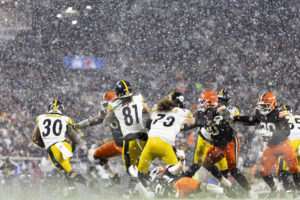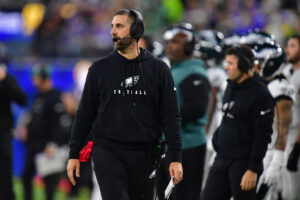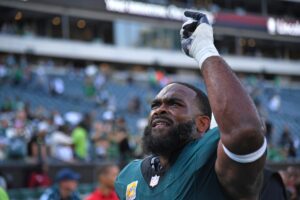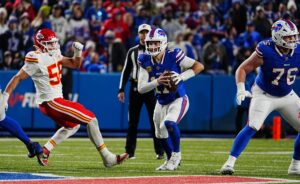It’s no secret that there are holes on the New England Patriots roster. Entering free agency, the Patriots clearly needed help in the front seven and at cornerback. While everyone expected Malcolm Butler and Dion Lewis to leave, things took a turn for the worst when left tackle Nate Solder and wide receiver Danny Amendola left for greener pastures. While these players meant a lot to New England, they are not irreplaceable. The New England Patriots free agency strategy has always been about finding the best value, and that’s not about to change this year.
Value Over Everything for New England Patriots Free Agency
The Players That Left: Danny Amendola and Dion Lewis
In a perfect world, Butler, Lewis, Solder, and Amendola would all be Patriots in 2018. Unfortunately for New England, it’s not a perfect world. Other teams wanted these talented players and were ultimately able to offer more than the Patriots could or would.
Butler leaving the Patriots was inevitable; Super Bowl LII ensured he’d never wear a Patriot uniform again. However, the other three could have been back in Foxboro at the right price. But what is the right price? Let’s take a look at the other three players and see how their deals compare to their value to New England.
Let’s begin with Danny Amendola. Amendola is a legend in New England for his postseason heroics, and the Patriots are probably still looking for their fourth championship without him. That being said, he is a health risk, on the wrong side of 30, and really isn’t much more than a role player in the regular season.
The Miami Dolphins gave Amendola a two-year, $12 million dollar deal with $8.25 million guaranteed. Had the Patriots matched this contract, Amendola would be on the books for more than fellow receiver Julian Edelman. Edelman is easily worth more than Amendola, and the Patriots know that. Signing Amendola for $6 million a year would not be financially responsible, and the Patriots don’t make financially irresponsible decisions.
Similar logic led to Lewis’ departure. Lewis took over as the lead back and was one of the best runners in the league. However, he wasn’t worth a long-term investment. He’s had health issues ever since entering the league, and 2017 was the first 16-game season of his career. Add in that running backs are a dime a dozen in today’s NFL, and it was natural to let Lewis go.
The Tough Decision: Nate Solder
Letting Lewis and Amendola go were relatively easy decisions. In Amendola’s case, Edelman is returning from injury, and he can do a lot more. In Lewis’ case, the Patriots already have a series of running backs capable of moving the ball.
The harder decision was letting Nate Solder go. Solder has consistently been one of the top 10-15 tackles in football ever since taking the left tackle job in 2012. While he’s a good player, Solder entered free agency set to be paid like a superstar. He was the only quality starting tackle in free agency, and with a weak draft, Solder was in line for a big paycheck.
Unlike Lewis and Amendola, the Patriots didn’t have a clear backup plan if they couldn’t re-sign Solder. Backup tackles Cameron Fleming and LaAdrian Waddle were also free agents, and are still no guarantee to return.
The Patriots current options at tackle aren’t exactly promising. They currently have four depth options who have combined for a total of eight snaps in their NFL careers. The most likely Solder replacement is Antonio Garcia, a third-round pick in 2016. He missed his entire rookie season with blood clots, so he’s anything but a sure bet.
Nonetheless, the Patriots stood by their business model. New England made a sizable offer, but the New York Giants made Solder the highest paid offensive lineman in football. Solder is good, but he’s not nearly the best offensive lineman in the game. Only time will tell if letting him go was the right decision, but there’s no debating that the Giants overpaid for Solder’s services.
The Cornerbacks They Didn’t Get
With so many players leaving in free agency, the Patriots needed to be active to find their replacements, right? Well, not necessarily. New England was linked to or had expressed interest in several big-name free agents, but ultimately didn’t sign any of them. While Patriots Nation was frustrated by this, it was all part of the plan for the Patriots organization.
All off-season, the Patriots were expected to be actively pursuing a cornerback to play alongside Gilmore. Possible replacements Aqib Talib, Richard Sherman, Trumaine Johnson, and many more came and went, and the Patriots did nothing to sign them.
Once more, this came down to value. Talib and his $11 million salary were traded to the Los Angeles Rams for a fifth-round pick. Sherman, who can’t even run yet, negotiated his own deal which could pay up to $13 million per year. And Johnson went to the New York Jets on a monster five-year, $61 million dollar deal.
The Cornerback They Got
All of these price tags were far above what the Patriots were willing to pay for a second cornerback. Instead of breaking the bank, the Patriots once more searched for value. New England sent their late sixth round pick to the Cleveland Browns for cornerback Jason McCourty and the Browns seventh-round pick.
McCourty is a good number two cornerback and is only due $3 million dollars this season. McCourty ended 2017 as the 27th ranked cornerback in football, per Pro Football Focus. By comparison, Malcolm Bulter finished the year ranked 51st in the league. If McCourty can keep up his 2017 play, then the Patriots actually upgraded their defense while also spending less than it would have taken to sign Butler, Sherman, or any other free agent.
The Run Defense Improvements
Pass rushers are arguably the most expensive non-quarterbacks in football, and improving the front seven was high on the Patriots to-do list. Despite this, Belichick has once again found a way to bring in smart, low-cost veterans to fill key voids on the team.
Rather than investing big money in a run-stuffing defensive tackle, Belichick bought low and traded for Cleveland Browns defensive tackle Danny Shelton. Shelton wasn’t a fit in defensive coordinator Gregg Williams‘ scheme, so it only took a 2019 third-round pick to acquire both Shelton and a 2018 fifth-rounder.
Shelton’s no superstar, but he certainly fills a big need. The Patriots had trouble stopping the run throughout the entirety of 2017, and Shelton thrives at stopping the run. This was a match made in heaven, and it took a very small shift in draft capital to get him.
Fixing the Edge
Additionally, the Patriots waited two days into free agency before signing former Atlanta Falcon Adrian Clayborn. Instead of overspending for similar talent, Belichick waited for the initial wave of free agency to happen. When the first rush of spending was over, Belichick assessed what remained on the market.
There were several players of Clayborn’s calibre available in free agency. However, most teams jump as soon as free agency starts, desperate to get their guy. Oftentimes, this leads to overspending, as teams desperately try to outbid each other for similar talent.
During this madness, Belichick sits back and observes. When the market gets calmer, Belichick pounces. This time, he grabbed an above average edge defender for the bargain price of a two-year, $12.5 million dollar contract. Clayborn immediately upgrades the defensive line, and is a plug and play starter alongside Trey Flowers.
Hunting down bargains isn’t the sexy move in free agency. It doesn’t sell jerseys or necessarily re-energize a fanbase in March. However, these moves lead to winning. This has been the Patriots strategy in free agency ever since Belichick took over in New England, and suffice to say it’s worked out. It’s hard to replace all the quality players leaving the Patriots, but the organization has a plan. In the end, they always do.






